It’s been no secret whatsoever that the Moto X was coming, but now it’s finally here. It’s the first cross-carrier hero phone out of Motorola since it was taken under Google’s wing. We just spent a little while loving it up, and here are our first impressions.
Design

One could argue that Motorola has not been so focused on design the last few years. At least not from a mainstream consumer standpoint. The whole RAZR line kind of catered specifically to geeks. It had hard angles, kevlar toughness, and scary robot eyes. This is very different. It’s incredibly smooth, with even the glass screen bending over the corners, making everything feel nicely rounded.
The back has a satisfying curve to it (even more pronounced than the curve on the HTC One). To accommodate that, Motorola had to build a special, non-rectangular battery (coming in at 2200 mAh). It has a stepped design, so that curved back is full of battery, instead of air.
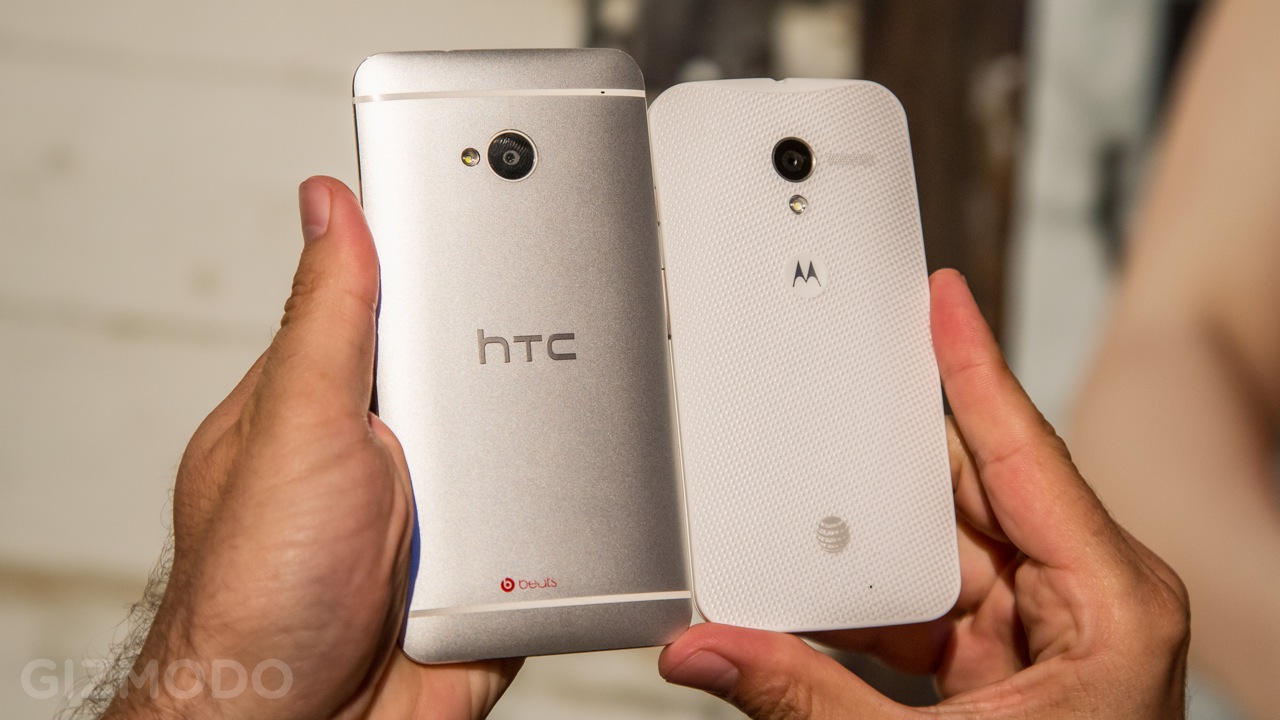
That’s kind of the theme for the build of the device. There is essentially no wasted space. The clearest way we can drive that home is that it has the exact same sized screen as the HTC One (4.7 inches), but the Moto X is significantly shorter and a bit narrower (5.09 x 2.57 inches for the Moto vs. 5.41 x 2.69 inches on the One). It also weighs 129 grams vs 142 grams on the One. This is quite a feat. You have a device with that same large screen but it feels much, much smaller in your hand and pocket.
We were told the back is a composite material, and while we don’t believe it’s that same RAZR-like Kevlar (we think it’s a slightly rubberised polycarbonate), it feels rock solid. It has a soft-touch finish to it, so it feels grippy yet smooth. Fingerprints won’t be a problem on it.
Up front there’s a 4.7-inch AMOLED display that comes in at 720 x 1280 pixels (or 316 PPI). That may be a disappointment for some who were hoping for a 1080p display like other flagship devices out there (the HTC one comes in at 468 PPI). The thing is, most people won’t notice or care. 316 PPI is still pretty damn pixel dense (the iPhone 5’s “Retina Display” is 326, by comparison. More so, the screen is bright, the colours looked good (and first glance), and the blacks were that inky darkness you know and love from an AMOLED screen. Suffice to say, 99 per cent of people who look at this screen will think it’s awesome. In fact, if someone told you it was 1080p you’d probably believe them.
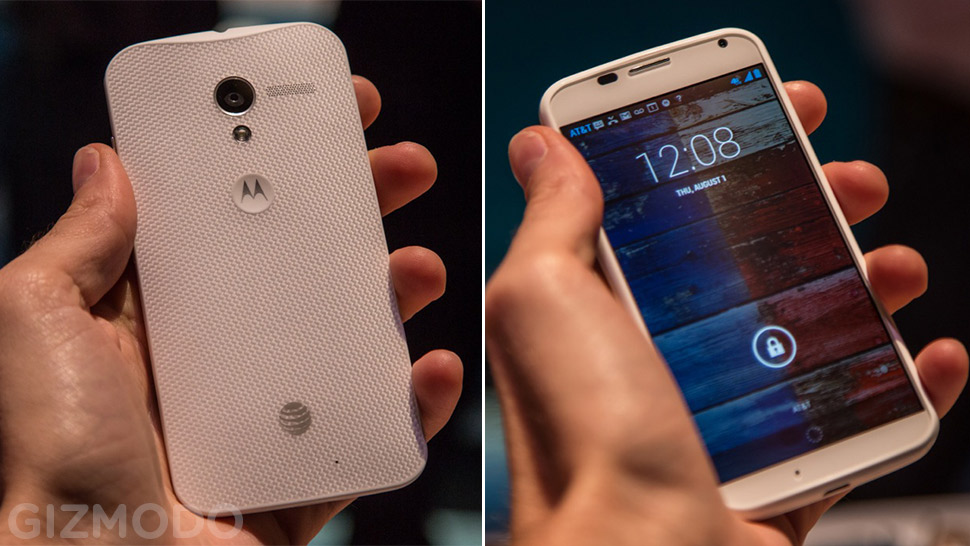
Performance
Motorola is doing something pretty unique with the guts on their new phones. It uses the new X8 Mobile Computing System. “It’s not a SoC (System on a Chip), it’s a series of discreet products that we put together on one board,” Motorola’s Steve Sinclair told me.
Geeks were worried because the CPU is a slightly dated Qualcomm Snapdragon S4 Pro dual-core clocked at 1.7GHz, but there’s also a quad-core Adreno 320 GPU, and two low-power processors, one for natural language and one for contextual computing. That’s a total of 8 cores, all optimised for different tasks. It also has 2GB of ram under the hood.
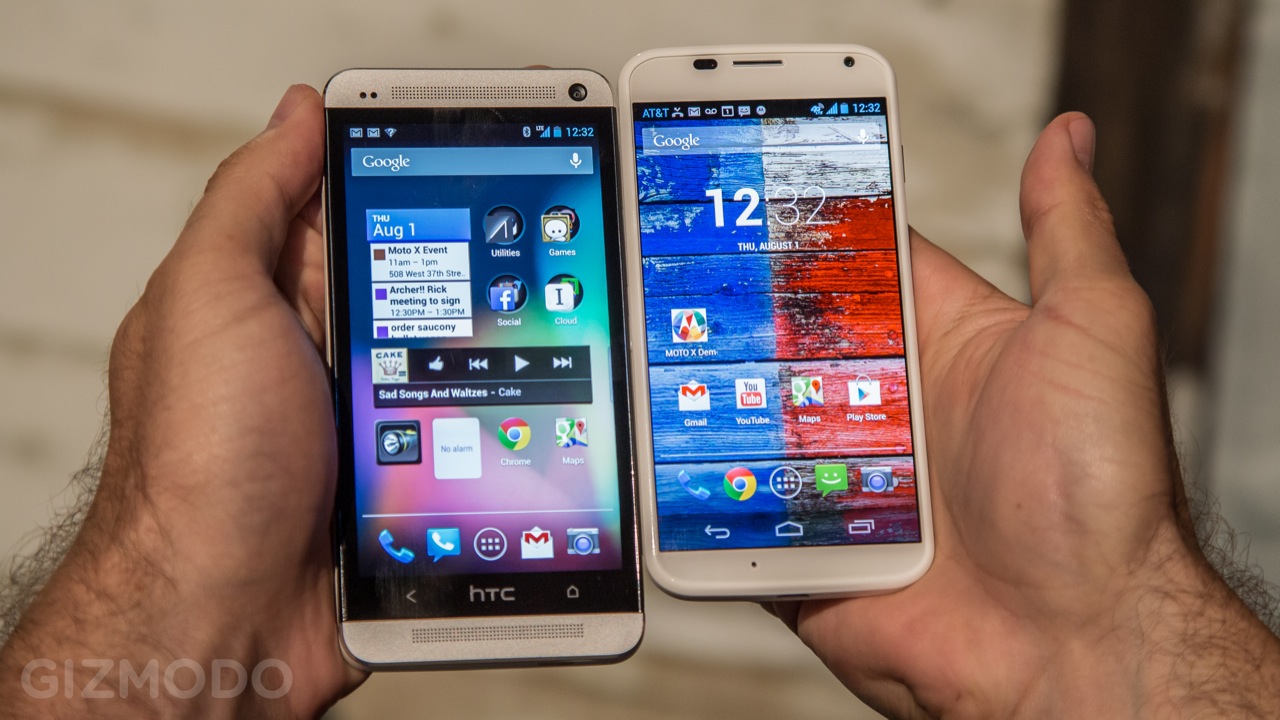
What’s actually important, though, is that it is FAST. In the couple hours that I’ve spent with it, I have seen zero lag or skipping. Experientially, it’s every bit as quick as the HTC One, Galaxy S4, or iPhone 5 (though we’ll see how it does after a longer period of testing). Apps fly open and scrolling is buttery smooth. We expect this will only improve when it gets the most recent Android update. Speaking of…
Software
Despite that fact that Motorola is now “a Google company,” the Moto X is launching with Android 4.2.2 (Jelly Bean). Android 4.3 was released just a week ago. It wasn’t a major update, but it should help speed things up even more and it will add support for Bluetooth 4.0 Low Energy. Despite that, the good news is that the Moto X is basically running stock Android. It’s very clean, and all the ugliness of MotoBlur is finally no more (though we do miss the improved dialer). Moto hasn’t really changed the design at all, and that’s a good thing. They have added a few significant features.
Touchless Control
This debuted last week with the new Motorola Droid line for Verizon in the US. Remember those low-power cores we mentioned a moment ago (one for natural language and one for contextual computing)? This is where they come into play. If you choose to enable it, Moto X will always be waiting for you to say “OK Google Now.” It will then spring to life to obey your voice command. That may include navigation, looking something up, making a call, sending a text or email, creating a reminder for yourself, setting an alarm, or any number of things. The coolest part is that you train it with your voice. The other guys at Giz HQ tried to wake it up by saying OK Google Now, but no dice. It obeys only me.
For the most part it seems to work pretty well, though it did have trouble with longer commands, like adding a calendar entry with a time, date, and location. It would definitely be very handy while driving. You can even configure it to read texts to you, and to verbally confirm the things you tell it to write, so you really don’t have to look at it (or touch it) at all.
Active Display
This is another cool feature. Moto did some research and claims that the average person turns their phone on and off 60 times per day. A lot of the time it’s just to check the time or to look see what notifications they have. You see the blinking light, and you want to know what it is. Rather than using a flashing LED, Active Display will briefly show the time of day and icons for whatever notifications you have waiting for you when you pull the phone out of your pocket or turn it over from face down. It does this using only the low-power cores (and because it’s AMOLED only the pixels that light up draw power), so Motorola claims that it uses very little energy.
If you get a new notification, the time and icon will gently pulse every now and then on your phone’s screen until you check it (assuming it’s face up on a table). If you touch the screen it will show you a preview of what it deems to be your most important notification, and swiping up will take you right to it. This is all customisable with security, of course (you won’t be able to go straight to it if you have your phone locked, and you can choose whether or not to display previews).
Camera
The Moto X has a 10MP shooter that uses a slightly different sensor technology than most other mobile phones. It’s called “Clear Pixel technology.” Rather than the typical RGB pixels, it has RGBC pixels (C is for “clear,” get it?). That fourth is basically dedicated to sucking up light. Motorola claims that it can collect 75 per cent more light than a traditional sensor. Combined with the f/2.4 on the Moto X, Motorola claims that it can take photos up to twice as fast as other leading smartphone in bright light, which should mean less motion blur. Indeed, at the demo we saw a photo snapped at fountain with individual water droplets frozen in the air. It looked super sharp, though we’ll have to test it for ourselves.
That technology should theoretically make it awesome in low light, too. We just had time to do one super quick test, but next to a shot from the HTC One the Moto X was brighter, but it was also a lot noisier and less sharp. Again, more testing is required.
The camera also has some unique software tricks. It can use the low-power (always listening) cores so that if you flick the phone with your wrist a couple of times it will go straight to the camera and be ready to shoot. They claim it can go from screen off to shooting a photo in two seconds. In practice, the gesture was very hit or miss. It worked maybe one of out three times for us. We’ll work on our technique.
Customisation
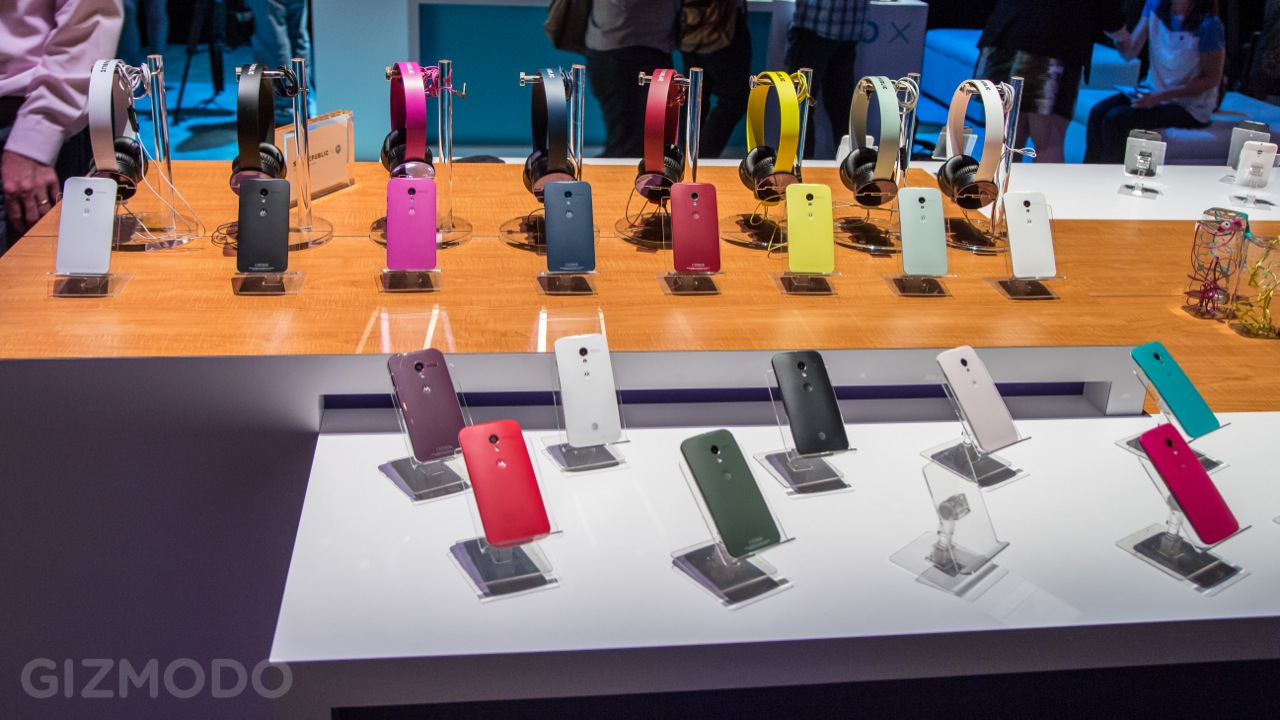
Borrowing from the automotive and shoe industries, the Moto X is going to be the most customisable phone yet. Moto Maker is going to be an online customisation store. You’ll be able to choose from 2 front colours, 18 back colours, 7 accent colours (the buttons, the ring around the camera), and even print a message on the back (like your email address, in case you misplace it). Customisation is included in the price and Motorola is promising delivery within four days. Which is pretty amazing. To accomplish this, every Moto X for the US will be made in Texas (which brought 2000 plus manufacturing jobs to Fort Worth).
You’ll also be able to choose matching Sol Republic JAX in ear headphones (again, included in the price, we believe). If you want larger over-ear headphones, you can customise Sol Republic’s Tracks HD headphones. Also, coming sometime in Q4, you’ll be able to select a wooden back, which looked and felt really sweet.
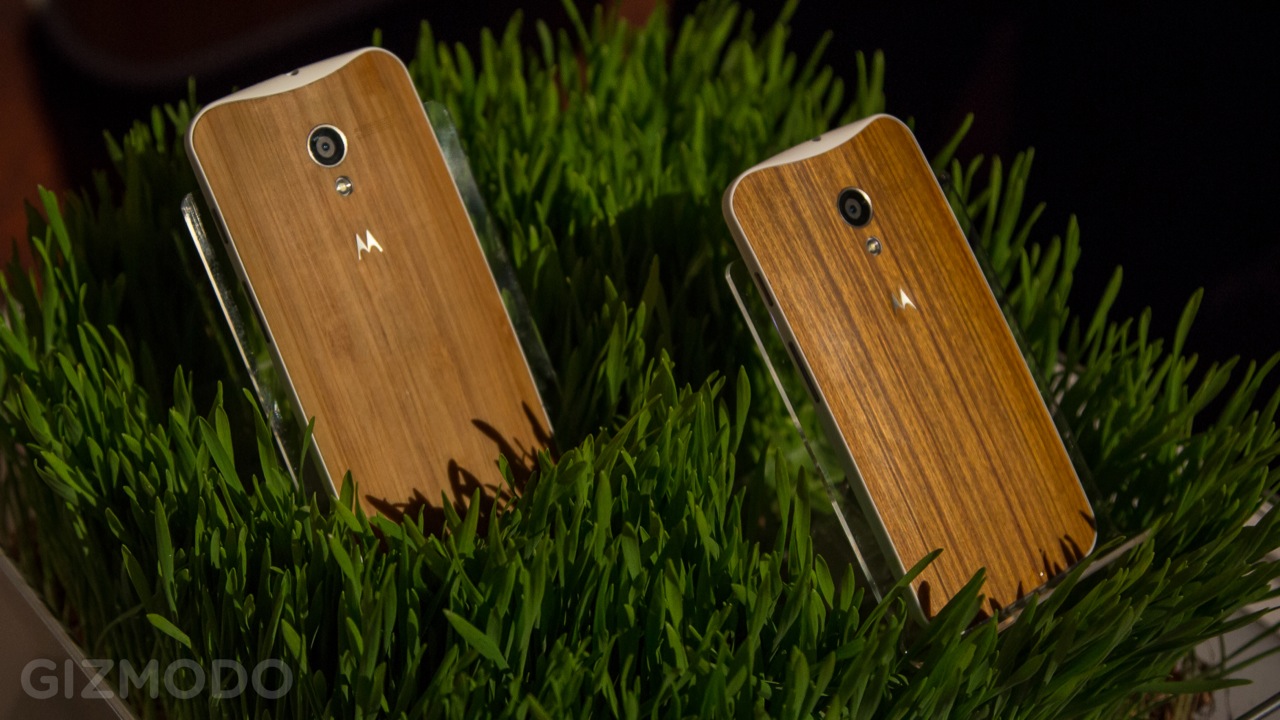
At launch, the Moto Maker customisation suite will only be for the AT&T variants. While Motorola couldn’t announce any additional partners with it, Motorola’s Rick Osterloh said they “obviously want it to go very broad,” so we’d expect more announcements soon regarding other carriers. For now, people will be able to go into an AT&T store, customise their phone on a computer, and then walk out the door with a white or black “loaner.” Their customised phone will arrive within four days, and then they bring the loaner back. It’s a pretty smart system. We’re not sure how customisable it will be for the Australian market, or even if it will be here at all. There have been strong rumours that Telstra has been in talks to carry the device, but those are still just rumours at this point.
Availability
The Moto X will be available in late August / early September on major US carriers. It also comes with 50GB of storage in Google Drive for two years. That’s in addition to the 15GB you already get for free. 65GB is nothing to sneeze at. There will also be an unlocked version of the Moto X coming to the Play Store, though pricing has not yet been announced for that (we were told we’d know closer to release).
Overall, we are extremely impressed with this phone and we can’t wait to put it through its paces. Stay tuned for a full review in the days to come.
